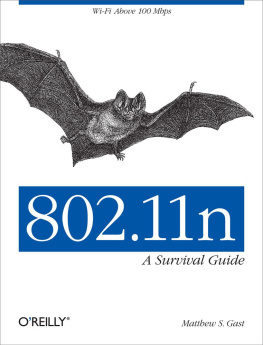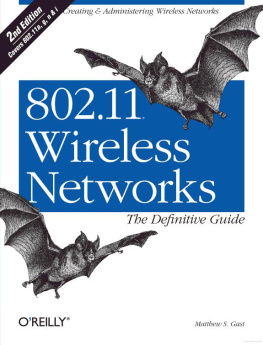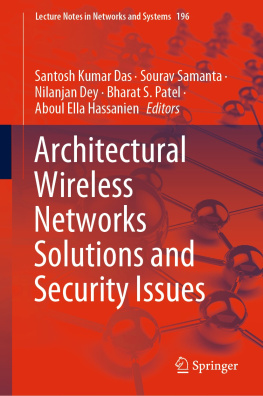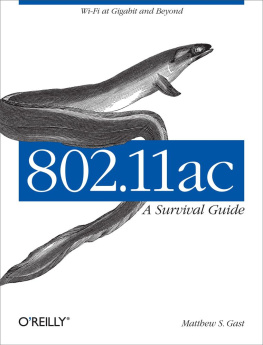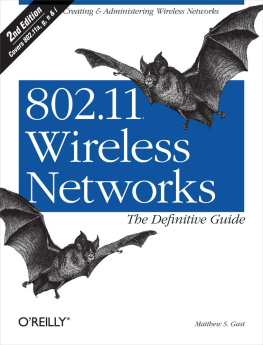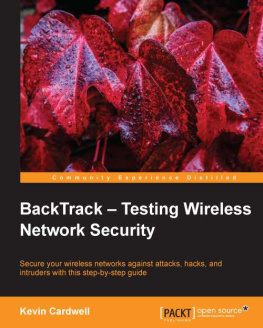802.11n: A Survival Guide
Matthew Gast
Copyright 2012 Matthew Gast
OReilly books may be purchased for educational, business, or sales promotional use. Online editions are also available for most titles (.
Nutshell Handbook, the Nutshell Handbook logo, and the OReilly logo are registered trademarks of OReilly Media, Inc. 802.11n: A Survival Guide, the image of a barbastelle bat, and related trade dress are trademarks of OReilly Media, Inc.
Many of the designations used by manufacturers and sellers to distinguish their products are claimed as trademarks. Where those designations appear in this book, and OReilly Media, Inc., was aware of a trademark claim, the designations have been printed in caps or initial caps.
While every precaution has been taken in the preparation of this book, the publisher and author assume no responsibility for errors or omissions, or for damages resulting from the use of the information contained herein.

O'Reilly Media
Dedication
In memory of Nicholas A. Jeremica
(December 5, 1977 - December 12, 2006)
And for Maria, Max, and Nicole,
who no doubt miss him even more than I do
Foreword
Adrian Stephens, January 2012
Communications is changing our life in many ways. Our society is increasingly dependent on wireless communications technologies and the applications they support. In the same way that we cant understand how the folks who lived in 1800 managed without anesthesia, television, (insert favorite must-have technology here), our children wont understand how we managed to grow up without on-the-go email, social networking, (insert technology x[] here).
IEEE 802.11 is a fundamental component of todays wireless communications technology. We have seen a rapid penetration of this technology into the enterprise (replacing or augmenting wired networks), home (wireless routers) and public spaces (airports, hotels). It is now no longer an optional feature, but an end-user expectation. IEEE 802.11n is the current must-have standard for wireless LAN that provides increased throughput and supports new applications and usage models. This book describes the development and operation of the 802.11n communications protocol. It provides background for understanding the impact of various features and settings on network operation and deployment. It is recommended reading for networking professionals and those who are curious as to what goes on under the hood. I have known Matthew Gast through our work together in the IEEE 802.11 working grouphe as chair of 802.11REVmb and I as its technical editor. He writes clearly with a minimum of jargon and a maximum of relevant example usage. His personal experience of wireless LAN standards development, product development, and product deployment shines through. He has turned what might be a dry subject into a surprisingly easy read.[] So, throw another log on the fire, pour your favorite libation, put your feet up, and settle down to
[] If I knew what x was now, Id make a fortune and retire. Of course, x will be obvious to our children and they will wonder how we never thought of it now.
[] Not an easy task, but given that he has managed to turn IEEE 802.11REVmb comment resolution into occasional high comedy, absolutely nothing is impossible.
Preface
People still move. Networks still dont.
A decade ago, I first wrote that people moved, and networks needed to adapt to the reality that people worked on the go. Of course, in those days, wireless LANs came with a trade-off. Yes, you could use them while moving, but you had to trade a great deal of throughput to get the mobility. Although it was possible to get bits anywhere, even while in motion, those bits came slower. As one of the network engineers I worked with put it, Weve installed switched gigabit Ethernet everywhere on campus, so I dont understand why youd want to go back to what is a 25-megabit hub. He underestimated the allure of working on the go.
In the rubble of the early 2000s Internet bust, wireless LANs were one of the first new technologies to cut through the gloom. As they gained in popularity, they morphed from an expensive toy to show off and became a must-have technology. My apartment had a wireless LAN very early, and I remember when I showed it off with pride. In the days of 2 Mbps 802.11 networks (or, if you were rich, an 11 Mbps 802.11b network!), all you had to do was beat the speed of your Internet link, which was not particularly hard.
What made 802.11n the next big step in the wireless revolution is that it was the first time that a wireless LAN delivered reasonable performance. Wireless LANs first took root in industries with highly mobile employees: hospital medicine, logistics, and education. Trading speed for mobility is a good exchange when you are on the move. It looks less attractive when you are relatively stable. 802.11n was the technology that buried the trade-off of speed for mobility. For the first time, it was possible to build a wireless network without compromise.
To build your network without wires, you dont have a choice: youre about to get familiar with 802.11n.
Audience
This book is about 802.11n, which was itself a major revision to the previous specification. To get the most out of it, youll need to be familiar with the basics of the 802.11 MAC and how it orchestrates access to the medium. It will help to be somewhat familiar with how 802.11 networks were designed before 802.11n came along. In a sense, this book is the 802.11n-specific companion to the earlier 802.11 Wireless Networks: The Definitive Guide (2nd edition), which was last revised in 2005.
The intended reader is a network professional who needs to delve into the technical aspects of 802.11n network operations, deployment, and monitoring, such as:
Network architects responsible for the design of the wireless network at their place of business, whether the 802.11n network is the first wireless LAN, or an upgrade from a previous 802.11 standard
Network administrators responsible for building or maintaining an 802.11n network, especially those who want to make the transition from earlier 802.11a/b/g technologies
One class of people for which Ive specifically not written is the security officer. Ten years ago, 802.11 and security were not usually used together in the same sentence, unless it was derisive. Of the many changes that have occurred in the world of 802.11 since I last put virtual pen to virtual paper, none pleases me more than the acceptance of 802.11 as a readily secured network access layer. As an industry, we fought the battle to secure wireless LANs, and we won. My position as chair of the Wi-Fi Alliances security efforts is generally boringand I hope it stays that way!
Conventions Used in This Book
The following typographical conventions are used in this book:
ItalicIndicates new terms, URLs, email addresses, filenames, and file extensions.
Constant widthUsed for program listings, as well as within paragraphs to refer to program elements such as variable or function names, databases, data types, environment variables, statements, and keywords.

